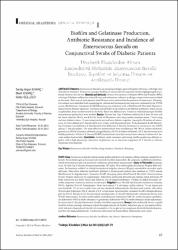| dc.contributor.author | Kıvanç, Sertaç Argun | |
| dc.contributor.author | Kıvanç, Merih | |
| dc.contributor.author | Güllülü, Gülay | |
| dc.date.accessioned | 2019-10-20T09:02:26Z | |
| dc.date.available | 2019-10-20T09:02:26Z | |
| dc.date.issued | 2013 | |
| dc.identifier.issn | 1300-0292 | |
| dc.identifier.uri | https://dx.doi.org/10.5336/medsci.2012-28313 | |
| dc.identifier.uri | https://hdl.handle.net/11421/16329 | |
| dc.description.abstract | Objective: Enterococcus faecalis is an emerging etiologic agent of hospital infections, with high rates of antibiotic resistance. Enteroccocci produce biofilms on intraocular lens materials, further highlighting their potential virulence for the eye. Material and Methods: Twenty-five patients [15 females (60%) and 10 males (40%)] with type II diabetes mellitus for at least10 years and without any infective or allergic conjunctivitis were included in the study. Both eyes of each patients (total 50 eyes) were analyzed for the presence of enterococci. Presumptive isolates were identified with morphological, cultural and biochemical tests and were confirmed by the VITEK system (BioMerieux). Automated EcoRI Ribotyping was performed with a RiboPrinter® Microbial Characterization System (Dupont Qualicon). Antibiotic susceptibility of the isolates to 10 different antibiotics, which are use as ophthalmic drop was determined by the Kirby-Bauer disc diffusion test. Virulence-related phenotypes (biofilm and gelatinase production) were studied. Results: Patients had Type II diabetes mellitus for at least 10 years and the mean value for HbA1c was 8.3±1.61. Seven of 25 patients were using insulin treatment alone, 7 were using oral anti-diabetics alone, 11 were using insulin and oral anti-diabetics together. Among the 26 isolates of enterococci, 24 were defined as E. faecalis and 2 as E. avium, with biochemical tests. With automated EcoRI Ribotyping, 24 isolates were defined as E. faecalis and 2 were defined as E. faecium. Resistance to vancomycin was 16.67% among E. faecalis isolates. The most effective antimicrobials were moxifloxacin (96.15% of isolates inhibited), gentamycin (92.3% of isolates inhibited) and gatifloxacin (92.3% of isolates inhibited). All E. faecalis strains were biofilm producers. While 14 E. faecalis (53.85%) isolates had a clear halo around their colonies 2 isolates of E. faecium isolates had no halo. Conclusion: Antibiotic multi-resistance and strong biofilm production abilities together with a high phenotypic expression of gelatinase are an important equipment of E. faecalis to colonize intraocular lens materials | en_US |
| dc.language.iso | eng | en_US |
| dc.publisher | Turkiye Klinikleri | en_US |
| dc.relation.isversionof | 10.5336/medsci.2012-28313 | en_US |
| dc.rights | info:eu-repo/semantics/openAccess | en_US |
| dc.subject | Bacterial | en_US |
| dc.subject | Biofilms | en_US |
| dc.subject | Drug Resistance | en_US |
| dc.subject | Enterococcus Faecalis | en_US |
| dc.subject | Ribotyping | en_US |
| dc.title | Biofilm and gelatinase production, antibiotic resistance and incidence of enterococcus faecalis on conjunctival swabs of diabetic patients [Diyabetik hastalardan alinan konjonktival sürüntüde enterococcus faecalis insidansi, biyofilm ve jelatinaz üretimi ve antibiyotik direnci] | en_US |
| dc.type | article | en_US |
| dc.relation.journal | Turkiye Klinikleri Journal of Medical Sciences | en_US |
| dc.contributor.department | Anadolu Üniversitesi, Fen Fakültesi, Biyoloji Bölümü | en_US |
| dc.identifier.volume | 33 | en_US |
| dc.identifier.issue | 1 | en_US |
| dc.identifier.startpage | 67 | en_US |
| dc.identifier.endpage | 72 | en_US |
| dc.relation.publicationcategory | Makale - Uluslararası Hakemli Dergi - Kurum Öğretim Elemanı | en_US |
| dc.contributor.institutionauthor | Kıvanç, Merih | |


















